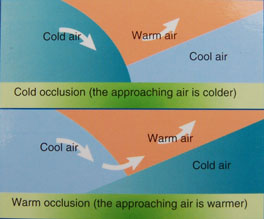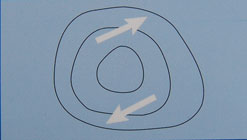Occluded fronts
Cold fronts generally move faster than warm fronts so eventually the cold front will catch up with the warm front (or occlusion). An occluded front may be described as “warm” or “cold” depending on the change of temperature as it passes, but both types generally produce cloud getting lower, then rain breaking up into showers.

Anticyclones (“Highs”)
Anticyclones, or areas of high pressure, are much less active than depressions.
Their isobars are usually more widely spaced than those of a depression, so winds are generally light and the weather is generally fine, though in winter the sky may be overcast.

Once an anticyclone becomes established its movement is likely to be slow and irregular, and it may remain stationary for days or weeks on end.
The atmospheric stability associated with a high is likely to promote coastal fog in spring and autumn. In summer, trapped dust particles may form haze.
Weather around depressions
The fronts associated with a typical depression divide the area around it into distinct sectors, each with distinctive weather patterns.
The warm front |
| Wind | increases and backs (e.g. SW to S) as the front approaches, then veers (e.g. from SW to W) as the front passes |
| Cloud | cloud cover increases and cloud base lowers as the front approaches |
| Weather | rain, becoming heavier and continuous |
| Visibility | reducing as the front approaches |
| Pressure | falling as the front approaches |
The warm sector |
| (between the fronts, generally S or SE of the depression’s centre) |
| Wind | steady |
| Cloud | low cloud, almost 100% cover |
| Weather | steady drizzle or light rain |
| Visibility | moderate or poor, possibly foggy |
| Pressure | steady |
The cold front |
| Wind | may increase and possibly back (e.g.from W to SW) as the front approaches then veers (e.g. from W to NW) as the front passes |
| Cloud | dense cloud, possibly towering to great heights at the front itself, quickly breaking up into to smaller puffy clouds once the front has passed |
| Weather | heavy rain, followed by showers once the front has passed |
| Visibility | poor in rain, then good or very good |
| Pressure | rises as the front passes |
The cold sector |
| Wind | may veer a little and freshen or become gusty immediately behind the cold front (depending on the depth and movement of the depression) |
| Cloud | apart from any frontal cloud nearby generally clear skies with scattered showers or white ‘fair weather cumulus’ |
| Weather | fair |
| Visibility | generally good |
| Pressure | depends on the depth and movement of the depression, but generally rises quickly as the cold front passes, then more slowly |
RYA Courses

Our Sailing school

Impression



















